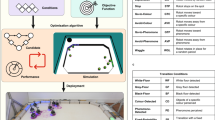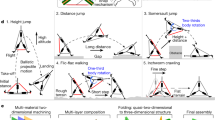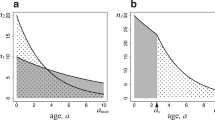Abstract
One of the greatest challenges in robotics is to create machines that are able to interact with unpredictable environments in real time. A possible solution may be to use swarms of robots behaving in a self-organized manner, similar to workers in an ant colony1,2,3,4,5. Efficient mechanisms of division of labour, in particular series–parallel operation and transfer of information among group members6, are key components of the tremendous ecological success of ants7,8. Here we show that the general principles regulating division of labour in ant colonies indeed allow the design of flexible, robust and effective robotic systems. Groups of robots using ant-inspired algorithms of decentralized control techniques foraged more efficiently and maintained higher levels of group energy than single robots. But the benefits of group living decreased in larger groups, most probably because of interference during foraging. Intriguingly, a similar relationship between group size and efficiency has been documented in social insects9,10,11. Moreover, when food items were clustered, groups where robots could recruit other robots in an ant-like manner were more efficient than groups without information transfer, suggesting that group dynamics of swarms of robots may follow rules similar to those governing social insects.
This is a preview of subscription content, access via your institution
Access options
Subscribe to this journal
Receive 51 print issues and online access
$199.00 per year
only $3.90 per issue
Buy this article
- Purchase on Springer Link
- Instant access to full article PDF
Prices may be subject to local taxes which are calculated during checkout




Similar content being viewed by others
References
Kube, C. R. & Zhang, H. Collective robotics: From social insects to robots. Adapt. Behav. 2, 189– 218 (1994).
Beckers, R., Holland, O. E. & Deneubourg, J. L. in Proceedings of the Fourth Workshop on Artificial Life (eds Brooks, R. & Meas, P.) 181–189 (MIT Press, Boston, 1994).
Deneubourg, J. L. et al. in Proceedings of the first International Conference on Simulation of Adaptive Behavior. From Animals to Animats (eds Meyer, J.-A. & Wilson, S. W.) 181–189 (MIT Press, Boston, 1990).
Bonabeau, E., Dorigo, M. & Théraulaz, G. Swarm Intelligence. From Natural to Artificial Systems (Oxford Univ. Press, Oxford, 1999).
Cao, Y. U., Fukunaga, A. S. & Kahng, A. B. Cooperative mobile robotics: Antecedents and directions. Autonom. Robots 4, 7–27 (1997).
Detrain, C., Deneubourg, J. L. & Pasteels, J. M. in Information Processing in Social Insects (eds Detrain, C., Deneubourg, J. L. & Pasteels, J. M.) 537– 547 (Birkhäuser, Basel, 1999).
Oster, G. & Wilson, E. O. Caste and Ecology in the Social Insects (Princeton Univ. Press, Princeton, 1978).
Wilson, E. O. Success and Dominance in Ecosystems: The Case of the Social Insects (Ecology Institute, Oldendorf/Luhe, Germany, 1990).
Jeanne, R. L. & Nordheim, E. V. Productivity in a social wasp. Per capita output increases with swarm size. Behav. Ecol. 7, 43–48 (1996).
Tschinkel, W. R. Sociometry and sociogenesis of colonies of the fire ant Solenopsis invicta during one annual cycle. Ecol. Mon. 63, 427–457 (1993).
Sundström, L. Sex allocation and colony maintenance in monogyne and polygyne colonies of Formica truncorum (Hymenoptera: Formicidae); the impact of kinship and mating structure. Am. Nat. 146, 182– 201 (1995).
Anderson, C. & Ratnieks, F. L. W. Task partitioning in insect societies. I. Effect of colony size on queueing delay and colony ergonomic efficiency. Am. Nat. 154, 521– 535 (1999).
Robinson, G. E. Regulation of division of labor in insect societies. Annu. Rev. Entomol. 37, 637–665 ( 1992).
Seeley, T. D. Honey bee colonies are group-level adaptive units. Am. Nat. 150, S22–S41 (1997).
Hölldobler, B. & Wilson, E. O. The Ants (Springer, Berlin, 1990).
Gordon, D. M., Paul, R. E. & Thorpe, K. What is the function of encounter patterns in ant colonies? Anim. Behav. 45, 1083– 1100 (1993).
Robinson, G. E. Modulation of alarm pheromone perception in the honey bee: evidence for division of labour based on hormonally regulated response thresholds. J. Comp. Physiol. 160, 613–619 (1987).
Robinson, G. E., Fahrbach, S. E. & Winston, M. L. Insect societies and the molecular biology of social behavior. Bioessays 19, 1099– 1108 (1997).
Bonabeau, E., Theraulaz, G. & Deneubourg, J. L. Quantitative study of the fixed threshold model for the regulation of division of labour in insect societies. Proc. R. Soc. Lond. B 265, 327–332 (1996).
Pacala, S. W., Gordon, D. M. & Godfray, H. C. J. Effects of social group size on information transfer and task allocation. Evol. Ecol. 10, 127 –165 (1996).
Mondada, F., Franzi, E. & Ienne, P. in Proceedings of the Third International Symposium on Experimental Robotics 1993 (eds Yoshikawa, T. & Miyazaki, F.) 501–513 (Springer, Berlin, 1994).
Wilson, E. O. The Insect Societies (Harvard Univ. Press, Cambridge, Massachusetts, 1971).
Seeley, T. D. The Wisdom of the Hive. The Social Physiology of Honey Bee Colonies (Harvard Univ. Press, Cambridge, Massachusetts, 1995).
Hölldobler, B., Möglich, M. & Maschwitz, U. Communication by tandem running in the ant Camponotus sericeus. J. Comp. Physiol. 90, 105– 127 (1974).
Möglich, M., Maschwitz, U. & Hölldobler, B. Tandem calling: a new kind of signal in ant communication. Science 186, 1046–1047 (1974).
Sokal, R. R. & Rohlf, F. J. Biometry. The Principles and Practice of Statistics in Biological Research 3rd edn (Freeman, San Francisco, 1995).
Acknowledgements
We thank J. D. Nicoud, E. Franzi, A. Guignard, A. Martinol, P. Maechler and K-Team SA for their sustained help, as well as A. Buchan, M. Chapuisat, T. Clutton-Brock, J.-L. Deneubourg, D. Gordon, B. Jeanne, J. Parker, F. Ratnieks, D. Queller, M. Reuter and K. Ross for comments on the manuscript. This work was funded by the ‘Fonds UNIL-EPFL 1997’, the ‘Stiftung für wissenschaftliche Forschung’ and several grants from the Swiss NSF.
Author information
Authors and Affiliations
Corresponding author
Supplementary Information
Rights and permissions
About this article
Cite this article
Krieger, M., Billeter, JB. & Keller, L. Ant-like task allocation and recruitment in cooperative robots. Nature 406, 992–995 (2000). https://doi.org/10.1038/35023164
Received:
Accepted:
Issue Date:
DOI: https://doi.org/10.1038/35023164
This article is cited by
-
Assessment of the risk factors of type II diabetes using ACO with self-regulative update function and decision trees by evaluation from Fisher’s Z-transformation
Medical & Biological Engineering & Computing (2022)
-
Radical embodied cognitive science and “Real Cognition”
Synthese (2021)
-
Trails of ants converge or diverge through lens-shaped impediments, resembling principles of optics
Scientific Reports (2020)
Comments
By submitting a comment you agree to abide by our Terms and Community Guidelines. If you find something abusive or that does not comply with our terms or guidelines please flag it as inappropriate.



